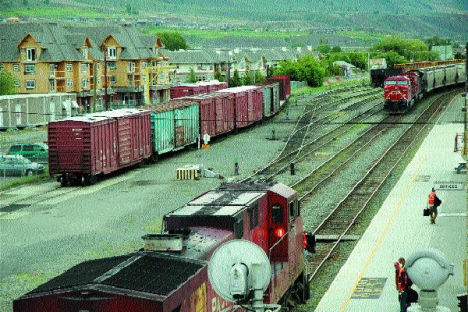 |
 |
|
|
|
|

2 June 2004
A Downtown Divided

The
CP Rail yard dissects the city's downtown. A
federally-sponsored report in 1978 recommended the rail
lines go underground.
|
Some view it as a downtown
divided. The rail lines that cut through the middle of the city centre, along with the presence of
the CP Rail yard, have acted as an impediment to a cohesive core, one which a Kamloops land developer
says could easily be remedied. "Right now our city centre is two ribbons divided by the railway
tracks," says Bill Bilton.
For him, the solution is simple, albeit costly - relocate the rail yard and put the mainlines
underground. It was discussed during a recent meeting between business people and the city's
planning department, and it's an idea that was extensively studied more than 25 years ago.
In fact, at the time, there was a recommendation to move forward with such a plan, but as federal
funds dried up, the plan found itself on a bottom floor shelf at City Hall.
Called the Kamloops Rail Relocation Project, the study was conducted under a federal initiative that
assisted cities in freeing up "redundant railway lands" and plan for future development.
Under the Railway Relocation Act of 1974, the government could have ordered railway companies to
relocate, with up to half of relocation costs paid by Ottawa.
In terms of the Kamloops project, the estimated cost, in 1978 dollars, was nearly $13 million with
the federal government contribution at $6.4 million.
"Downtown is cut off from its most valuable asset - the South Thompson River waterfront,"
stated one of the many reports written in 1978.
It's a sentiment still echoed today.
Frank Rossi, a realtor with Sheridan Realty, considers the presence of the CP Rail yard near the
bottom of Third Avenue as one of the biggest hurdles the city faces for downtown development. And
David Trawin, who oversees the planning department at City Hall, agrees the elimination of the CP
Rail yard would open up a whole new world of opportunities. "It gets rid of an eyesore, attracts
development, generates more taxes and brings more people to the downtown," says Trawin, who
suspects this discussion will be repeated again next year as the city reviews and updates its city
centre plan.
If the city were to purchase the CP Rail property, Trawin says it would eventually pay for itself
with the increased taxes generated through new development.
Greg Toma, who worked in the city's planning department in the late 1970s, recalls the Kamloops
Rail Relocation project as one which had a big vision, and one which would have spurred growth in
the downtown. Thirty-two acres of land - which are still home to mainlines, sidings
and buildings - would have been freed up and become prime real estate, and, more importantly,
says Toma, would have finally linked the two sides of the downtown.
Under the rail plan, the proposed location for a new rail yard would have been farther west,
between the Weyerhaeuser settling ponds and the sewage lagoon. Ed Greenberg, CP Rail spokesperson,
says any thought of moving the main rail yard would obviously have to go through extensive review
and discussion.
|
|
|